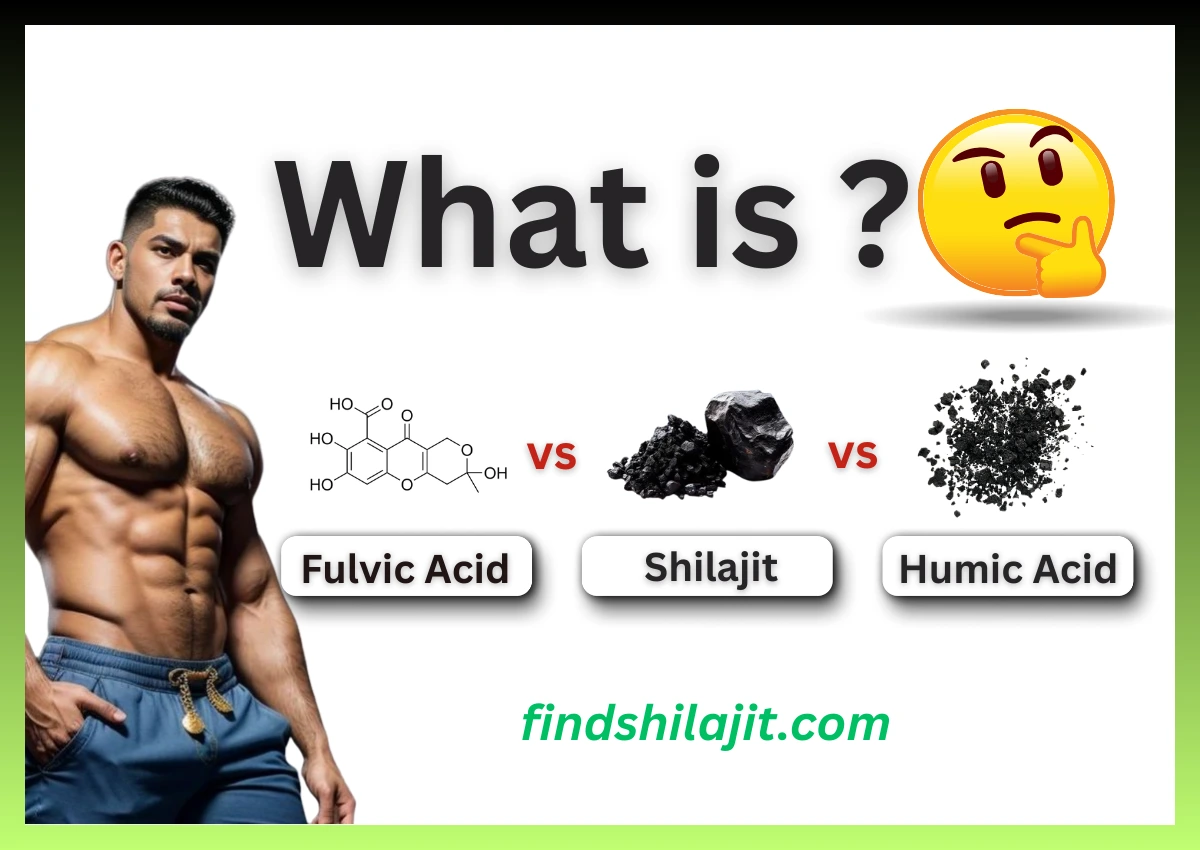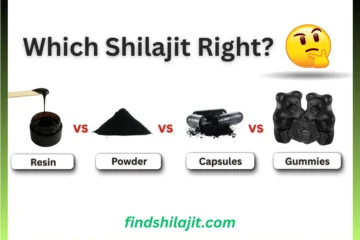Do you know what fulvic acid vs shilajit vs humic acid is? These three natural health compounds have rapidly gained popularity in the health and wellness world over the past decades.
Did You Know?
Fulvic acid in Shilajit helps carry over 70+ minerals directly into your cells — making it one of nature’s best nutrient transporters.
You may have often heard them mentioned in discussions around energy, detoxification, nutrient absorption, etc. While they share a common origin in organic decomposition, each has distinct characteristics that set them apart in terms of composition, sourcing, and health potential.
Today, we will do a comprehensive comparison of fulvic acid, shilajit, and humic acid, exploring their benefits, Major differences, scientific backing, and how they’re used in modern health practices.
With evidence-based insights and practical guidance, you will gain a clear understanding of how each supplement works and which may be best suited for your needs.
Key Takeaways:
- Fulvic acid, shilajit, and humic acid are naturally derived from organic matter and are rich in minerals, vitamins, antioxidants, and bioactive compounds.
- We knew they often grouped; they differ significantly in structure, solubility, origin, and concentration of beneficial compounds like fulvic acid.
- In this post, we will explore their individual benefits and reviews.
What is Shilajit?
It is a sticky, black-colored, tar-like substance that naturally oozes from rocks in high mountain ranges from 6000 ft to 1800 ft, like the Himalayas, Altai, and Caucasus.
It’s formed over decades and centuries from the slow decomposition of plant and living matter and minerals, and has been used for thousands of years in Indian Ayurveda as a powerful rejuvenator.
Its composition is rich in fulvic acid, over 80 trace minerals, and bioactive compounds like dibenzo-alpha-pyrones, known to support energy and cell function.
Shilajit is available in various forms—resin (the most potent has a high active compound), powder, and capsules for convenience.
Traditionally used to boost vitality, vigor, stamina, and male fertility, it’s now gaining attention for its modern uses in supporting energy, brain function, and recovery.
What is fulvic acid?
Fulvic acid is a naturally occurring compound that forms when organic living matter decomposes over time; think decaying plants, leaves, and microorganisms in soil. It’s one of the key components of humic substances, which also include humic acid and humin. What makes fulvic acid unique is its very small molecular size and its powerful ability to bind and transport nutrients into your body.
Do you know this low molecular weight allows fulvic acid to penetrate cell membranes easily, making it a natural bioavailability booster?
In simple terms, it helps your body absorb minerals, vitamins, and other nutrients more efficiently. That’s why it’s often used in supplements to enhance energy, gut health, detoxification, and nutrient uptake.
In terms of structure, fulvic acid is rich in electrolytes, trace minerals, amino acids, and antioxidants.
It also acts as a natural chelator, meaning it can bind to heavy metals and toxins, supporting the body’s natural detox process.
Beyond supplements, fulvic acid is widely used in the agriculture sector as a soil enhancer. It helps plants absorb nutrients more effectively, improves soil structure, and supports microbial activity, which leads to healthier crops and higher yields.
Much research has also linked fulvic acid to anti-inflammatory, antioxidant, and immune-modulating effects, making it a growing focus in both natural medicine and health science.
Fulvic acid is a powerful natural compound that works behind the scenes to support nutrient absorption and overall vitality for both humans and plants.
What is Humic Acid?
Humic acid is also a natural substance made from the breakdown of organic matter in soil, like plants and microbes. It’s part of the humic substances group and is known for its larger molecular size compared to fulvic acid.
While it’s too large to enter into your body cells directly, humic acid works mainly in the gut to bind toxins, mainly support digestion, and strengthen the gut barrier. It’s also valued for its detoxifying and anti-inflammatory properties.
Another hand in agriculture, humic acid is widely used to enrich soil, improve nutrient retention, and boost plant growth. In health supplements, it’s gaining popularity for supporting gut health, cleansing the body, and balancing the microbiome.
Key Differences—Fulvic Acid vs Shilajit vs Humic Acid
| Parameter | Fulvic Acid | Shilajit | Humic Acid |
| Origin | Formed from decayed organic matter in soil | Mountain exudate formed from ancient plant material | Boosts nutrient absorption, detox, and energy |
| Chemical Structure | Small organic acids, low molecular weight | Complex mix: fulvic acid, minerals, dibenzo-alpha-pyrones | Large complex organic acids |
| Molecular Weight | Low | Medium (contains fulvic and humic components) | High |
| Absorption Rate | Very high (enters cells easily) | Moderate to high (depends on form & quality) | Low (works mostly in the gut) |
| Taste & Appearance | Slightly bitter, light golden to brown liquid/powder | Earthy taste, sticky black-brown resin or powder | Bitter, dark brown to black powder |
| Use in Human Health | Supports energy, stamina, and hormone balance | Gut health, detox, and inflammation control | Gut health, detox, inflammation control |
| Use in Agriculture | Used to increase nutrient uptake in plants | Rarely used | Widely used for soil health and crop growth |
| Form Availability | Liquid, powder, capsules | Resin, powder, capsules | Powder, capsules |
| Main Health Benefits | Detox, absorption, cellular energy | Vitality, anti-aging, recovery | Gut detox, immune support |
Health Benefits Compared
Shilajit Benefits
- Boosts energy & stamina—acts as an adaptogen to reduce fatigue and enhance mitochondrial function, helping overall physical performance
- Enhances fertility & testosterone—Clinical studies show ~37% increase in sperm count and ~23% rise in testosterone at 90 days
- Anti-aging & cognitive support—Rich in antioxidants (e.g., fulvic acid), it helps reduce inflammation and may slow Alzheimer’s-related changes
- Supports recovery & immunity—Traditionally used for altitude sickness and overall resilience
Fulvic Acid Benefits
- Nutrient transport & absorption—Low molecular weight acts as a natural chelator, enhancing uptake of minerals and vitamins into cells
- Detox support—Can bind heavy metals like cadmium and lead up to ~90%, helping remove toxins
- Gut & skin health—Anti-inflammatory and antioxidant, helps improve gut microbiome and support skin conditions.
- Immune modulation—Studies suggest it influences oxidative state and immune response in chronic conditions
Humic Acid Benefits
- Gut microbiome & intestinal health—Shows promise in enhancing barrier integrity, balancing gut flora, and reducing colitis in human/mammal studies
- Supports immune function—acts locally in the gut to reduce inflammation and strengthen cellular immune responses.
- Detox support—binds harmful substances in the digestive tract and may aid in removing aflatoxin‑like toxins.
Safety, Side Effects & Precautions
All three—fulvic acid, shilajit, and humic acid—are generally safe when taken in proper doses and sourced from high-quality, lab-tested products.
The main concern is heavy metal contamination, especially in cheap or unpurified shilajit. Always choose reputable brands that provide third-party testing and are suggested by your health specialist.
Fulvic Acid: Safe for most people and well tolerated. May cause mild digestive upset at high doses. Avoid during pregnancy, breastfeeding, and in young children without medical guidance.
Shilajit: Effective, but must be purified. Raw or low-quality shilajit may contain harmful metals. Not recommended for pregnant women, children, or those with kidney conditions. May interact with certain medications.
Humic Acid: Safe for short-term gut and detox support. Less studied for long-term internal use. Avoid in people with kidney issues or those on medications that affect electrolyte balance.
How to Choose the Right One for You
Choosing between fulvic acid, shilajit, and humic acid depends on your specific health goals and body needs. Here’s a simple guide to help you decide which one is good:
- Choose fulvic acid if you want to improve nutrient absorption, support gut health, and enhance detox on a cellular level. It’s ideal for daily use and well tolerated by most people.
- Go for Shilajit if you’re looking to boost energy, stamina, or support testosterone and fertility. It’s best for active individuals or those needing recovery and vitality—just make sure it’s purified.
- Pick humic acid if your focus is gut detox, improving the microbiome, or supporting immune function. It’s especially helpful for those with digestive issues or toxin buildup.
Still unsure? Some high-quality supplements combine fulvic and humic acids to offer balanced benefits. As always, consider your health status and consult with a healthcare provider if you’re managing a condition or taking medications.
FAQs
Can I take fulvic acid, shilajit, and humic acid together?
Yes, many supplements combine fulvic and humic acids, and it’s generally safe to take them with shilajit as well. Just ensure you’re using high-quality, purified products.
Which one is best for energy and stamina?
Shilajit is the top choice for energy and stamina support. It contains fulvic acid and unique compounds like dibenzo-alpha-pyrones, which support mitochondrial function and physical endurance.
Is fulvic acid better than shilajit?
They serve different purposes. Fulvic acid is better for nutrient absorption and detox, while shilajit offers broader benefits like hormonal support, energy, and anti-aging effects.
Are there any side effects of long-term use?
Shilajit and humic acid can also be used long-term if they are properly purified and used as directed. Side effects are rare but may include digestive upset or mineral imbalance in sensitive individuals.
How can I tell if a product is pure and safe?
Look for supplements that are third-party tested for heavy metals, toxins, and microbes. Reputable brands will clearly share lab results, sourcing details, and certifications on their website or label.
Conclusion
Choosing between fulvic acid, shilajit, and humic acid comes down to your specific health needs, whether it’s energy, detox, gut health, or nutrient absorption.
Each offers unique benefits, and understanding their differences helps you make an informed choice.
I hope this guide gave you a clear picture of how these natural compounds work.
If you found this post helpful or have experience with any of these supplements, I’d love to hear your thoughts! Drop a comment below and let us know your feedback on fulvic acid vs shilajit vs humic acid.
Disclaimer
This article is for informational purposes only. Please consult a licensed healthcare provider before starting any new supplement, especially if you are pregnant, breastfeeding, or on medication.
Also Read:



